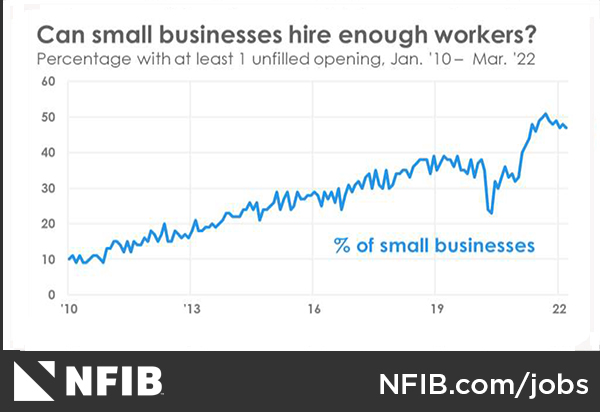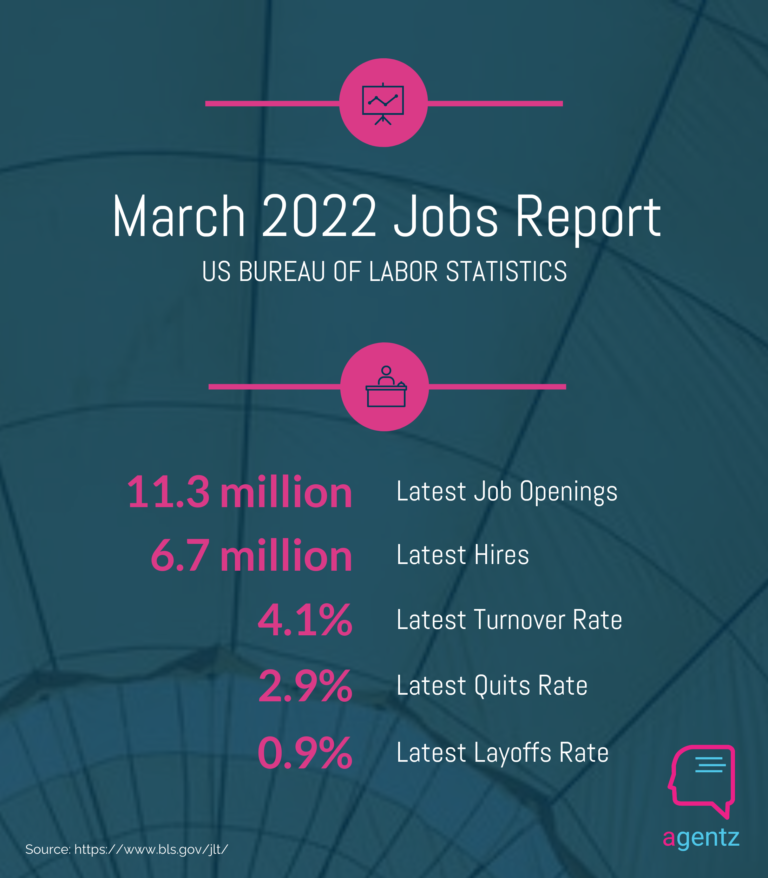Remote work instigated the “Great Resignation” as a record 47.4 million workers voluntarily left their jobs in 2021 alone. For some, it was a chance to retire early. For others, it was a desire to simply stay home and raise their family or take extended time off.
The Bureau of Labor Statistics March 2022 jobs report shows an increase in job openings to 11.3 million at the end of February, continuing the upswing from the 10.9 million at the end of December.
Despite the increase in total job openings, for the twelve months ending in February 2022, there was a net employment gain of 6.4 million due to the 77.0 million new hires made compared to the 70.6 million in separations.
So then how do total openings continue to rise? Per Goldman Sachs, there are approximately 2.5 million people missing from the workforce.
The Great Resignation Becomes the Great Reshuffle
Small businesses, in particular, have been negatively impacted by the Great Resignation. Compared to larger enterprises that can more easily absorb workloads with less staff, small businesses who are understaffed experience greater stress.
In some cases, owners are reducing their workload by taking on fewer customers and cutting hours and services. Others require their teams to simply take on more work. This increased productivity with fewer staff has the negative consequence of extreme burnout with 54% of employees feeling overworked and 39% exhausted.
What happens when your team is overworked and exhausted? They quit, seeking greener pastures at companies that provide a better work/life balance. Thus, the Great Resignation becomes the Great Reshuffle as employees consider a move. Forty-one percent of employees are considering changing jobs over the next year.
Will small businesses benefit or bear the brunt of the Great Reshuffle?
Lack of Qualified Labor and Rising Cost of Compensation Top Concerns for Small Business Owners
The NFIB Jobs report reveals that 60% of owners reported hiring or trying to hire in March with 47% having job openings they could not fill. Of those openings, 39% are for skilled workers and 23% for unskilled. Ninety-two percent of hiring owners reported few or no qualified applicants for their positions.
But it’s not just a matter of identifying qualified candidates. Equally concerning is the 48-year high of businesses reporting labor costs as their top business problem.
A net 49% (seasonally adjusted) of owners report having raised compensation, an increase of four points from February. Also increasing is the net 28% who plan to raise compensation in the next three months.
Per Bill Dunkelberg, NFIB Chief Economist, “The labor shortage has not eased on Main Street as the number of job openings exceeds the number of unemployed workers. Owners have continued to increase their compensation in March to attract the right employees for their open positions.”

New Consumer Behaviors Creating Challenges for Business Owners
Just as remote workers were forcibly immersed into the world of Zoom, Trello and cloud workspaces to communicate with their teams, consumers are shoving small businesses into the deep end with their desire to communicate via SMS and direct messaging (DM) apps like Facebook Messenger and Google Messages.

If managing these additional channels isn’t challenging enough, 83% of consumers expect an immediate response – 24/7. Demanding! Traditional phone calls, alone, are missed by small businesses at an average clip of 30%. Those missed calls result in lost customers and revenue.
Responding fast is hard when fully staffed but nearly impossible when understaffed. Without the aid of small business communication technology, that is.
Engagement & Communication Automation Tools Cover Short-staffed Teams
For those business owners struggling to keep up with customer communication in an understaffed environment, purpose-built automation has come along at just the right time in the form of engagement and communication automation tools (ECATs.)
ECATs are front-line platforms that interact with customers, 24/7, across multiple channels including SMS, Direct Message apps, website properties and voice. Never taking a day off or calling in sick, ECATs engage with customers handling routine tasks and questions, allowing them to self-service many of their needs.
Comprehensive ECAT’s can also seamlessly transition the 30% of missed calls to an automated SMS conversation, keeping callers engaged instead of moving on to the next business.
These unique capabilities make ECATs the perfect backup plan for business owners struggling to keep up with customer leads and communications.
ECATs Provide Beneficial Customer Deflection
Common use cases that enable customers to self-service their needs through automation are booking appointments, having questions answered, taking messages and directing customers to take desired actions – things like viewing special offers, reviews, work samples, and new offerings – all without requiring a human to intervene live.
This “customer deflection” allows customers to self-service up to 30% of their needs – and be thrilled with the convenience.
Conversely, due to lack of product fit, service area, or budget mismatch, some customers are not desirable. No business wants to waste time on mismatched prospects in favor of spending time on the right customer. ECATs help with this. By engaging with and responding to their questions, ECAT’s can inform prospects they might be better served elsewhere – this helps save precious time for the business.
These customer deflections enable front desk staff to save upwards of 20% of their time, allowing them to focus on priority tasks and customers.
ECATs Save on Headcount Costs
The cost of hiring and training new people is very high. Estimates range from one-third to 3x salary depending on the position. The ability to leverage technology designed to be a back up to staff and offload some of their work, make ECATs a desirable tool for improved business operations.
For customers, ECATs allow them to communicate with businesses how they prefer – on their own terms, any time, and from any device, without requiring human intervention.
About Agentz
Agentz is the first true, comprehensive ECAT for small business.
Designed for ease of use, the Agentz automated assistant is a no-code, out of the box experience that can be setup and enabled in minutes by the business owner – not hours or weeks by an engineer as with other solutions.
Agentz is the only solution that provides full multi-channel communication capabilities along with a pre-trained knowledgebase that can answer questions for many common business questions as well as those specific to industries such as within home services, legal, medical and real estate.
Learn how the Agentz automated assistant can help you respond to your customers faster, grow your business, and make operating your business easier.



